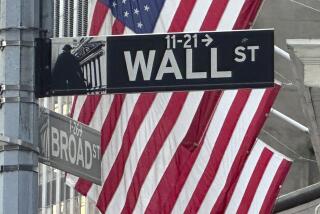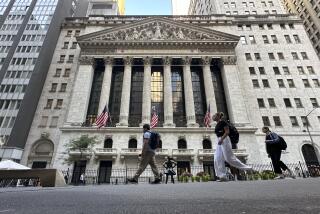Dollar Falls Against Euro
Fresh selling of major technology stocks Wednesday drove the Nasdaq composite index to its lowest close since mid-April, though the broad market didn’t fare as badly.
In currency trading the dollar continued to tumble against the euro and the yen as traders ganged up on the U.S. greenback.
Nasdaq slumped 45.64 points, or 2.3%, to 1,918.89, the seventh loss in eight sessions and the lowest close since the index finished at 1,909.57 on April 16. Nasdaq hit a two-year low of 1,638.80 on April 4.
Tech stocks faltered again as investors registered their doubts about a meaningful turnaround in the U.S. economy occurring soon. Losers swamped winners by 21 to 15 on Nasdaq in modest trading.
Falling tech shares included Oracle, down 54 cents to $15.01; BEA Systems, down $1.56 to $17.04; Cisco Systems, off 65 cents to $17; and Dell Computer, down $1.07 to $25.50.
Tech investors appeared to ignore a Federal Reserve report showing that output at the nation’s factories, mines and utilities fell only slightly in July--suggesting that manufacturing might be poised for a rebound.
“People are disbelieving of anything positive. A year and a half ago, nobody would believe a negative thing, and now we’re at a point when nobody believes anything positive,” said Scott Bleier, investment strategist at Prime Charter Ltd. in New York.
The broader market was mixed. The Dow Jones industrial average eased 66.22 points, or 0.6%, to 10,345.95, but winners outnumbered losers by 8 to 7 on the New York Stock Exchange.
Analysts said the market’s main problem isn’t that sellers are pouring in, but rather that potential buyers have moved to the sidelines. “When the indexes fall it’s because there is a lack of interest, not because everyone is dumping shares,” said Larry Wachtel, market analyst at Prudential Securities in New York.
Some stock players may have been worried that the Fed report on factory output could keep the central bank from cutting its key short-term interest rate next week, which would be the seventh cut this year.
Treasury bond yields, which have been tumbling in recent weeks, rose Wednesday after the Fed report. The yield on the two-year T-note closed at 3.79%, up from 3.68% Tuesday.
Higher rates didn’t help the dollar, however. It sank to a five- month low against the euro and to the weakest level in two months versus the yen.
The dollar ended in New York at 91.3 cents per euro, the weakest since March 14. On Tuesday it took 90.2 cents to buy one euro.
The dollar also dropped to 119.67 yen from 121.74 on Tuesday.
Investors “are moving away from the U.S. right now,” Tim Mazanec, currency strategist at Investors Bank & Trust, told Bloomberg News. “The momentum is definitely on the side of a weaker dollar.”
The dollar’s sixth day of losses versus the euro--the longest losing streak this year--was partly fueled by speculation the Bush administration is backing off its strong- dollar policy.
Analysts tied the talk to a scheduled TV appearance Wednesday by Treasury Secretary Paul H. O’Neill. But O’Neill reconfirmed the administration’s currency stance.
“We have a continuing and continuous policy,” on the dollar, O’Neill told CNBC. “We’ve still got the same dollar policy.”
Still, major U.S. exporters have complained to the administration in recent weeks that the dollar’s strength is a drag on earnings. A strong dollar makes U.S. products more expensive overseas.
In the stock market, energy shares were a pocket of strength. They got a boost as natural gas futures prices scored their biggest gain in eight months after a report showed U.S. gas inventories rose less than expected last week, as a heat wave spurred cooling demand in the East.
Supplies in underground storage rose 3 billion cubic feet to 2.29 trillion, the smallest increase this year, the American Gas Assn. said.
Near-term gas futures jumped 12.1% to $3.47 per million British thermal units in New York.
Among energy shares, Chevron rose $1.42 to $93.01, Halliburton leaped $2.30 to $32.84 and Burlington Resources gained $1.50 to $43.57.
Market Roundup, C7-C8
More to Read
Inside the business of entertainment
The Wide Shot brings you news, analysis and insights on everything from streaming wars to production — and what it all means for the future.
You may occasionally receive promotional content from the Los Angeles Times.










